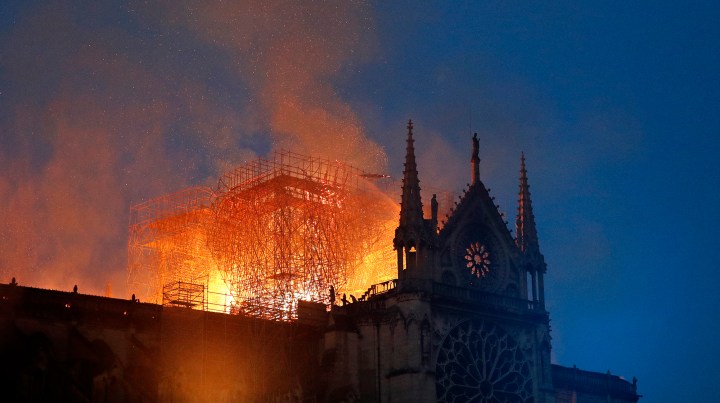IN MEMORIAM
Notre Dame – a modest proposal

The destruction of much of Notre Dame Cathedral, along with yet other worship sites in Sri Lanka, Louisiana, and Jerusalem, prompts an idea of how to harness this devastation in order to encourage the global community to share in the rebuilding and restoration of these places of worship and contemplation.
Like so many others, years ago, on a business trip to Paris, my Parisian counterparts thought the very best thing for me to do after a busy day of meetings was to have supper in a neighbourhood brasserie that offered a totally unobstructed view of the Cathedral of Notre Dame, directly across the river from where we sat. That evening, the cathedral was lightly shrouded in mist, and with the glow from street lamps and the cathedral’s own lights, the building took on a mysterious, near-spectral look.
The resulting scene was the perfect moment for any impressionist painter worth his or her salt to capture the beauty of the scene. But unlike so many other millions of people over the centuries, I failed to take a single photograph, nor did I sketch or paint the scene to help me remember it. I still can recall it vividly, even if I have no memory of what I ate. My host had insisted I sit so that I faced the church, thereby making it very hard to concentrate on the ostensible purpose of our conversation, as I stared and stared across the Seine at that church directly in front of me.
This monument was the sum of the labours of armies of stonemasons and unknown artists, and thousands of labourers; a building borne from the ambitions of priests, kings, and laymen alike, and stemming from a collective sense of religious fervour. But there was also the imagined presence of Victor Hugo’s Esmeralda (Maureen O’Hara) and Quasimodo (and thus Charles Laughton), among the bells in one of the church’s towers to build yet more layers of meaning onto the church.
And so, like so many millions around the globe, this writer was stunned and shocked by the conflagration that nearly engulfed that cathedral just days ago. The televised images of the cataclysmic engulfing of the towers beamed into our household just like everyone else’s for hours on end.
But even as the embers still glowed, reports were coming in of pledges of some very large amounts of money in competing “I see your pledge and I will make a still bigger one” – from French business families, eager to be among an elite circle of donors who would help resurrect the famous cathedral. Cynics have argued they were also guided by a more mixed set of motivations, including the chance to harvest vast amounts of publicity over a full decade on all the construction signs on site, in social media, and in glossy fashion magazine pages, in being a saviour of the church’s rebuilding. There was also the benefit of demonstrating a deep sense of public spiritedness on the part if their company in rescuing a part of the national, even international cultural patrimony; as well as gaining a vast tax deduction against their enterprises’ corporate taxes.
But almost as soon as the donations from the L’Oreal and LVMH crowd were announced, naysayers and critics began asking why such huge sums were being pledged to fix up an old building, instead of directing this vast pile of lucre towards more important things like ending world poverty, curing cancer, ensuring the destitute had food, clothing and shelter, and averting a global environmental catastrophe instead. Others, naturally, argued in response that these were private individuals and businesses and they were certainly entitled to use their funds in whichever way they chose, according to their personal tastes and interests – and within the law. And in any case, the critics almost certainly had no knowledge as to whether or not those donors were already making major donations to all those urgent, worthy causes. (In all probability they were routinely doing just that already.)
It is important to remember that many of the world’s ultra-rich have, in the past hundred years or so, done just that with a good chunk of their wealth. Think Alfred Nobel and his prizes; Andrew Carnegie and his libraries across America and South Africa, as well as a university and his endowment for the study of global peace; much of the Bill and Melinda Gates fortune going to educational improvement and world health; and the global impact of the Rockefeller and Ford Foundation’s donations across many disciplines in every corner of the world.
But beyond all the good works, the ultra-rich have endowed whole research universities, museums, concert halls and music conservatories that have glorified their names, but without such facilities, the world would be a much grimmer, aesthetically and culturally poorer place. There are, of course, many, many more foundations around the globe, named after their respective benefactors, than those mentioned above, as the rich discovered that simply having vast gobs of money isn’t quite enough to still the night terrors about what it all glorified once they have cashed in mightily on what economic theorist Thorstein Veblen had identified as the urgent drive towards conspicuous consumption. (Nobody really needs – but many want – a closet full of Louis Vuitton bags, and a wine cellar of Moët et Chandon champagne or Hennessy brandy from the House of LVMH.)
And so here we are: the rich have queued up to lavish millions on a rebuilding project of one of the great monuments of civilisation, even as, instead of getting equally lavish praise, they have been rebuked for their vanity, instead of ending world hunger instead. There is an answer to this criticism – and to make the rebuilding of that French cathedral a true universal effort. The salvage and restoration effort must be broadened out in the way people join in, and at the same time make such an effort more inclusive of what needs saving or restoring.
Think about this bit of history. Back in the latter half of the 19th century, the French government had decided to construct a giant statue commemorating freedom and liberty and then give it as a gift to the American people. Rather than funding it as a national governmental project, millions of the French people were encouraged to send their contributions to the organisers, in contributions big and small. Even children were caught up in the enthusiasm of this effort, saving their centimes and paying them into the fund as well. Once the statue was completed, it was shipped to the US, but the large plinth for the statue remained unbuilt for several years as major sponsors were lacking.
Newspaper magnate Joseph Pulitzer then made it his own cause, publishing the names of every donor, no matter how small the amount of their contribution, and leading the cheer-leading to raise sufficient funds to reach the needed amount. Collectively, these examples became some of the first crowdfunding efforts, with contributors feeling they had, together with millions of others, joined in to have been part of something much larger than themselves.
So here is our proposal for the reconstruction of Notre Dame. In a few months’ time, once all the forensics are completed on the burnt, fallen timbers from the roof, those giant beams can be cut into smaller, more uniform pieces and, together with certificates of authenticity, be provided to people around the world who make a contribution to a special fund set up for the renovations. These pieces should prove enormously popular worldwide, and it is almost guaranteed, assuming the marketing is done with the right blend of piety and salesmanship, that they will fly off the shelves so to speak. (I have several such commemorative items at home, including a certified rock from Robben Island, as well as a sliver of a famous, now-discontinued rail line from Japan, although they were gifts, rather than purchases by me.) Lest someone complain about the commercialism of such a plan, my reading of European history tells me that the sale of religious indulgences was once rather widespread, and that there once was a vigorous trade in holy relics between clever marketers in the Middle East and eager Western pilgrims, adventurers, or soldiers of fortune.
But in the same time period as the great fire at Notre Dame, three black churches in Louisiana were also burned, as was a portion of the al Aqsa Mosque, and several churches in Sri Lanka were bombed during Easter services. So, how about using a portion of the remittances from these portions of the roof from the Notre Dame Cathedral to endow a global fund dedicated to supporting the restoration of damaged centres for religious worship, regardless of creed or denomination? Sadly, if Notre Dame’s damaged, seared wood beams ever run out, given the intemperate, intolerant, destructive times we live in, there will certainly be other destroyed or damaged holy sites in the future which will be in need of help.
Do I hear any international organisation or foundation willing to take up this challenge? DM




















 Become an Insider
Become an Insider